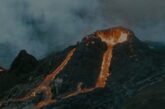.jpg)
Peru Uses Climate Change To Lure Tourists To Glacier
Almasalla Arab Travel Portal News – In its heyday the Pastoruri glacier in central Peru drew throngs of tourists packed into dozens of double-decker buses 16000 feet (5,000 metres) high into the Andes to ski build snowmen and scale its dizzying peaks.
It was so bright with ice and snow that sunglasses were mandatory.
But in less than 20 years, including at least 10 of the hottest on record, Pastoruri has shrunk in half, and now spans just a third of a square mile (0.9 square km).
Melting ice has given way to slabs of black rock, two small lakes gathering the glacial runoff have swollen together, and officials have banned climbing on the unstable formation.
"There isn’t much left of our great tourist attraction," said local guide Valerio Huerta. "Tourists now always leave totally disappointed."
The dwindling number of visitors to Pastoruri – 34,000 last year compared to an estimated 100,000 per year in the 1990s – has eroded tourism earnings that support thousands in the Cordillera Blanca, Peru’s most popular cluster of snowy peaks.
Now locals are making a bid to lure tourists back to Pastoruri before it is gone completely – likely in a decade.
Instead of marketing Pastoruri as the pristine Andean winter wonderland it once was – visible in old pictures that still hang in hotels and restaurants in nearby towns – the peak is being rebranded as a place to see climate change in action.
The "climate change route," to officially launch in March, is the latest offbeat answer to rising temperatures that have eaten up 30 to 50 percent of Andean glaciers in recent decades.
Peruvians have insulated ice with sawdust to stave off melting and painted exposed rock white to reflect sunlight.
Those experiments curb glacial retreat on a small scale, but cannot bring ice blocks like Pastoruri back from the brink, said Selwyn Valverde with the Huascaran National Park, home to Pastoruri and more than 700 other shrinking Peruvian glaciers.
"It’s irreversible at this point," he said, adding that Pastoruri is no longer technically a glacier because it does not build up ice in the winter to release in the summer. "It’s just loss, loss, loss now. It doesn’t accumulate anymore."
Peru is home to 70 percent of the world’s tropical glaciers, formations particularly sensitive to temperature increases.
Supporters of the route say Pastoruri, an hour-long flight from Lima and then another hour’s drive from the regional capital Huaraz, is perfectly positioned to show the world the impacts of warming that will one day be widespread.
On the climate change route, visitors pass marshes and ponds red with rust as they walk over a hill that was once ice.
"Smell the water," Valverde said, bringing a handful to his nose. "Do you smell the iron?"
Mountain rocks covered for years are shedding minerals as ice melts off them – rendering water undrinkable with high levels of heavy metals such as cadmium and iron, Valverde said.
Newly exposed rocks have also revealed fossilised marine species that likely last saw the light of day before the start of the last ice age – more than 100,000 years ago.
‘BORING’ TO WATCH GLACIER DISAPPEAR?
Pastoruri is still a striking chunk of ice, but it is unclear if tourists, even the more science-minded tourists being targeted, will come to watch its demise.
In Huaraz, Korbinian Munster, a German tourist, said he took his guide book’s advice and skipped the day trip to Pastoruri, instead opting for rock climbing on an iceless mountain nearby.
Seeing climate change up close did not appeal to him.
"I prefer visiting nice things," Munster said. "Seeing something that once was a glacier sounds quite boring and sad."
Pastoruri is not the only popular spot affected by climate change. As warmer temperatures tweak ecosystems, boost the frequency of extreme weather and degrade coastlines, the global map of favourite tourist destinations is slowly being redrawn.
Warming waters are intensifying coral bleaching at Australia’s Great Barrier Reef, and increasingly regular flooding in Venice could limit future visits.
But for some, the passing nature of Pastoruri is the allure.
"They say it’s disappearing," said tourist Santiago Florian, as he caught his breath on a hike toward Pastoruri. "I wanted to be able to say after it’s gone that I was here."
NO CHOICE BUT TO ADAPT
As water trickles off Pastoruri, local vendors idle at a row of food and coat-rental stands near its base.
"I used to sell 30-40 plates of food per day," said Nelisia Tuya, stirring a pot of lamb and yucca soup. "Now it’s 2-3, or maybe 5-6 at the most. And that’s with fewer of us selling."
Some of Tuya’s former competitors – all, like her, from the nearby Quechua-speaking community of Catac – have trailed Pastoruri’s melting ice into cities below in search of jobs.
There are no official figures on falling revenues linked to Pastoruri’s retreat, but Marcos Pastor with the state agency charged with protecting natural sites said about a quarter of people who live in and around the Cordillera Blanca depend on glacier tourism.
The threat to tourism might seem trivial compared with other potential climate change impacts.
Expanding glacier-fed lakes threaten to wipe out entire towns if they burst, minerals leaching into watersheds pose new health risks, and millions along Peru’s crowded desert coast will eventually face diminishing supplies of water.
But tourism is an important source of cash for hundreds of towns in the Peruvian Andes, where there are relatively few jobs and the trickle-down benefits of a long metals boom can be hard to find.
"Tourism is one of the few economic activities in Peru that distributes money directly to locals," said Pastor.
At Pastoruri that means money not just for food vendors but for those who service outhouses or rent horses, bus drivers, guides and companies that coordinate trips from city desks.
Travel agent Artidoro Salas with Andes Hard Expeditions said he has thought of leaving his hometown Huaraz to start a tourism venture where there is stronger demand – maybe Cusco, the home of the popular Incan ruins at Machu Picchu.
"There are at least eight travel agencies that have gone out of business here over the past decade – and those are only the ones I know of," said Salas. "Pastoruri has been a big problem. It was the main reason tourists used to come here."
Salas has gotten by tailoring trips for adventure travellers, and is curious to see if a niche market for climate change tourism might grow from the melted remains of Pastoruri.
Park official Valverde said the route aims to inspire, not depress. He pointed to lichens and mosses that have managed to thrive in oxidised puddles at the foot of Pastoruri.
"If they can adapt to that, why can’t we, too, adapt to climate change?" he said. "The reality is that we already are. That’s what this route is all about."
Source : Reuters








